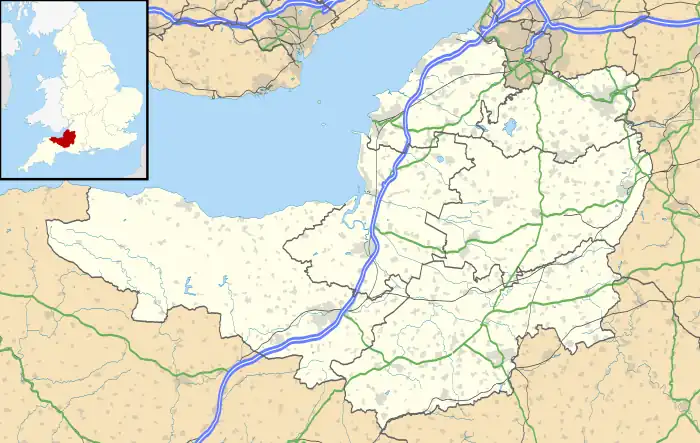| Church of All Saints | |
|---|---|
 Location of Church of All Saints in Somerset | |
| Location | Rodden, Somerset, England |
| Coordinates | 51°13′42″N 2°17′22″W / 51.2283°N 2.2895°W |
| Built | 1640 |
Listed Building – Grade II* | |
| Official name | Church of All Saints |
| Designated | 11 March 1968[1] |
| Reference no. | 1058893 |
The Anglican Church of All Saints in Rodden, Somerset, England, was built in 1640. It is a Grade II* listed building.[1]
History
The church was built in 1640, on the site of an earlier medieval church.[2] Although it served only a small community, the church was built on the orders of Archbishop William Laud.[3] He was an autocratic clergyman and sought to reduce the influence of Puritans, after which Laudianism is named.[4]
The church was dedicated to St Blaize, and served as a chapelry of Boyton, some 11 miles (18 km) to the south-east in Wiltshire,[5] both Rodden and Boyton being estates of the Giffard family in the 13th century.[6] The date this arrangement ended, and Rodden became a separate parish, is unclear. It is described as a chapelry in a correction note to the 1811 Census[7] but the 1831 Census Abstract states the separation occurred in 1784.[8] John Collinson, published in 1791, has Rodden as a chapelry of Boyton.[6] Another source gives the creation date of Rodden ecclesiastical parish as 1802.[9]
The church was rebuilt in a Victorian restoration in the mid-19th century.[1]
The benefice was united with that of Berkley in 1964.[10] Today the parish is part of the benefice of Beckington with Standerwick, Berkley, Lullington, Orchardleigh and Rodden, which was created in 1978, within the Diocese of Bath and Wells.[11][12]
Architecture
The stone building has a three-bay nave and one-bay chancel with tile roofs. The west tower is supported by diagonal buttresses.[1] The majority of the interior dates from its restoration in the 19th century, but it retains its 18th-century pulpit.[1]
Present day
The church, in spite of its isolated location, continues to have services once or twice a month.[13]
See also
References
- 1 2 3 4 5 "Church of All Saints". National Heritage List for England. Historic England. Retrieved 12 January 2018.
- ↑ Historic England. "Church of All Saints (1058893)". National Heritage List for England. Retrieved 8 February 2022.
- ↑ "Rodden, Somerset, Family History Guide: extract from Lewis' A Topographical Dictionary of England, 1848". Parish Mouse. Retrieved 8 February 2022.
- ↑ Dunning, Robert (2007). Somerset Churches and Chapels: Building Repair and Restoration. Halsgrove. p. 54. ISBN 978-1841145921.
- ↑ Willis, Browne (1742). A Survey of the Cathedrals of York, Durham. T. Osborne. p. 137.
- 1 2 Collinson, John (1791). The History and Antiquities of the County of Somerset. pp. 226–227 – via Internet Archive.
- ↑ Abstract of the Answers and Returns Made Pursuant to an Act Passed in the Fifty-first Year of His Majesty King George III, Intituled, "An Act for Taking an Account of the Population of Great Britain, and of the Increase Or Diminution Thereof" : Preliminary Observations, Enumeration Abstract, Parish Register Abstract, 1811. Vol. vi. H.M. Stationery Office. 1811. p. 282.
- ↑ 1831 Census Abstract: Vol. 3 p.280 – via Internet Archive
- ↑ "Rodden EP". A Vision of Britain through Time. University of Portsmouth. Retrieved 8 February 2022.
- ↑ "No. 43323". The London Gazette. 15 May 1964. p. 4193.
- ↑ "All Saints". A Church Near You. Church of England. Retrieved 12 January 2018.
- ↑ "No. 47603". The London Gazette. 28 July 1978. pp. 9084–9086.
- ↑ "All Saints, Rodden". Beckington Benefice. Retrieved 8 February 2022.
Further reading
- Day, John K. (2001). Rodden Church, Frome. Frome Society for Local Study. ISBN 978-0948014338.